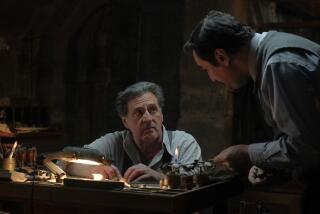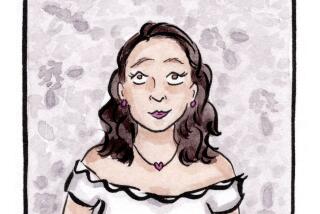The outsider within us
Charlotte von Mahlsdorf scoops the last of her strawberry yogurt from its plastic cup. With a satisfying smack, she downs the last dollop. It’s Feb. 2, 1993, and tonight I’ve been interviewing her for more than four hours. One day, I hope to forge a play from the disparate puzzle pieces of her life.
“It’s late,” she says in her signature lilt. She peers at me cautiously and asks, “You are going to take a taxi back to West Berlin, yes?”
Indeed I am. Charlotte lives in an eastern suburb, about 40 minutes by commuter train from the city’s hub. It’s a forbidding neighborhood: drab buildings with barren window boxes, and a surplus of disaffected youth, many of them skinheads. Naturally, I’m not fond of taking the subway to and from her home at odd hours.
“Do you mind if I share the ride?” she asks me. I’m surprised; it’s almost 11 p.m. She explains, “I’ve been invited to a party in town.”
Our driver is in his 50s, squat with closely cropped hair, a crumpled cap and a grizzled chin. His forearms are like giant drumsticks. I’m nervous. Will Charlotte invite his enmity? After all, he doesn’t look especially open-minded, and Charlotte just happens to be a man: an elderly gay transvestite who survived both the Nazis and the Communists as an open cross-dresser. To make matters worse, she’s instantly recognizable; a bestselling autobiography and a documentary film have made her a cult celebrity in Berlin.
Brazenly, Charlotte sits up front, next to our new friend. I crawl into the back. The cabbie shoots an ominous look at me in his rearview mirror, then shifts the car into reverse with an insolent jolt.
I sit stoically during the ride, but Charlotte is merrily prattling on about a host of subjects: the weather, the demise of the East German automobile called the Trabant, drag balls under Kaiser Wilhelm, and Thomas Edison’s invention of the phonograph. Her merry cadences are the only sound, other than the roar of the motor.
I’m focused on the driver. What’s running through his head? Nasty epithets? Is he smirking at this elderly gent in a lady’s coat, trundling into town with her queer American friend? Will our ride culminate in an ugly incident?
Finally we arrive at Charlotte’s destination: a swank apartment building near the Kurfurstendamm. She smooths her skirt as she slides out of the passenger seat. Beaming at me, she exclaims, “Danke schon!” Then she heads daintily up the steps, her hips swaying ever so slightly.
Once again the cabbie catches my face in the mirror. “Charlotte von Mahlsdorf,” he says with a mixture of awe and unmistakable civic pride. “A true Berlin original, ja?”
In the years to come, I see it happen again and again: Charlotte, charming potential adversaries into submission. On a book tour in the East, a conservative tire magnate giggles like a schoolboy and kisses her hand. A middle-class mother with a baby on her hip asks Charlotte for her autograph. On a typical Sunday morning when Charlotte offers guided tours of her home, a rustic museum of late 19th century antiques, the crowd that mills outside waiting to gain admission is diverse: hipsters in leather, gay couples, straight backpackers and stout old German ladies with dour husbands in tow. Once this motley crew ambles inside -- as Charlotte effuses about credenzas and ink pots -- they all regard her with the same beatific smiles.
Why is such a willful eccentric so appealing to so many? For me, it’s a crucial question. After all, I hope to mold her life into drama. And I’m not keen on merely preaching to the choir. I’d like the play to reach a broad audience. Naturally, I hope that my fellow gay men and women will find the piece meaningful, as a compelling chapter in our largely forgotten history. But I’ve always believed that if a subject is truly worthy, it will speak to everyone. Can my stage version of Charlotte boast the same charisma as the genuine article? Will the play attract an audience? Or will my leading “lady” be written off as a freak?
I’m consoled by one thought: Like the greatest and most enduring characters, Charlotte is larger than life. She reaches beyond the particulars of her time, place and idiosyncratic nature to embody lasting truths.
Her very life is a trope for history. A compulsive collector, Charlotte preserved the culture that she knew not by writing about it but by saving its remnants, precious objects that tenaciously survived the 20th century’s two most lethal regimes.
When the Nazis were looting Jewish homes during World War II, Charlotte followed with a junk cart, rescuing lamps, bronze busts and recordings of banned composers such as Mendelssohn and Offenbach. During the Cold War -- when the Russians threatened to destroy a Weimar-era cabaret in Berlin’s red light district -- Charlotte rescued each table, each cane-back chair, each faded menu and each bottle of liquor, hiding them all in her basement. In room after room of her homegrown museum, she kept a fractured, tumultuous country intact. (In 1992, the German Cultural Ministry awarded her a prestigious medal for her preservation efforts.)
This hobby makes her more than heroic; it makes her simpatico. Everyone has an aunt or grandmother who lovingly hoards -- souvenir thimbles, perhaps, or Hummel figurines, or faded copies of Life magazine. Charlotte simply took this penchant to extremes; she preserved an entire slice of bourgeois German culture.
Charlotte has another, less visible collection: the anecdotes she loves to share about her life. In telling them over the years to tourists and journalists, she’s polished them to a high sheen, just like her cherry wood breakfront. When she recounts her time as a nervous teen in the Hitler Youth, or her imprisonment in a detention center, the tales have a rehearsed, carefully cadenced sound, rendering them precise and strangely implausible at the same time. These narratives are every bit as precious to me as her antiques. They raise fascinating, eternal question about the nature of history itself: When is it pure, and when is it tainted by the private, sometimes covert agenda of the historian?
“But what about her transvestism?” I ask myself. “The pleated skirts, the prim stockings, the sleeves that taper to the cuff only to reveal large, thick, rough-hewn hands? To some, won’t this always render her exotic or, worse still, peculiar?”
Once they’ve been demystified, however, even Charlotte’s sartorial quirks are no longer alienating. They become a point of commonality. We all dress to convey our innermost selves: a bright scarf for the bon vivant, sober pinstripes for the serious professional. Our clothes announce our perceptions about ourselves: baggy sweaters that say, “I’m worried about my weight!” or spandex tank tops that boast, “I actually use my gym membership.”
In her simple black dresses and restrained jewelry, Charlotte was merely expressing her truest qualities: a femininity in spite of her biological sex, an emulation of her beloved mother, a marked nostalgia for an earlier time, a reverence for simplicity. True, we don’t all count cross-dressers among our acquaintances. But who among us doesn’t know a dandy, a clotheshorse or a fashionista? In Charlotte’s seeming eccentricity, we see our own habits, writ large.
I reassure myself with another heartening fact: Stories about outsiders are so popular that they’ve become cliches. In our hearts, we are all solo travelers, fighting against a sea of homogeneity -- the runt striving to make the football team, or the homely girl who morphs into the beauty queen. What better tale than the awkward, effeminate young German boy, draped in his mother’s shawl, outsmarting storm troopers? These anecdotes nourish our perpetual love affair with the underdog. Charlotte’s story reminds us that even our darkest insecurities can become a source of strength.
There are countless other characters -- both in life and in drama -- who have become icons for phenomena greater than themselves. Donald Trump has become synonymous with cutthroat capitalism. The name Hugh Hefner connotes a freewheeling hedonism. Blanche DuBois is synonymous with delusional self-invention, and Hamlet is indecision personified. These figures endure in our consciousness because they embody key aspects of our experience in the world.
Is my beloved Charlotte worthy of this pantheon? Is she a living, breathing illustration of history’s necessity in our lives? In person, she was. I can only hope that my play makes its case for her as artfully as she did for herself.
*
Doug Wright won the Pulitzer Prize and the Tony Award for “I Am My Own Wife.” His other plays include “Quills” and the upcoming musical “Grey Gardens.”
More to Read
The biggest entertainment stories
Get our big stories about Hollywood, film, television, music, arts, culture and more right in your inbox as soon as they publish.
You may occasionally receive promotional content from the Los Angeles Times.






